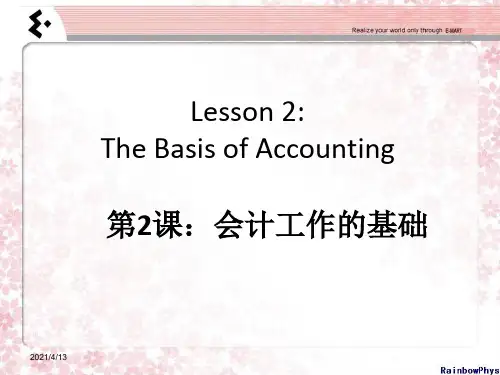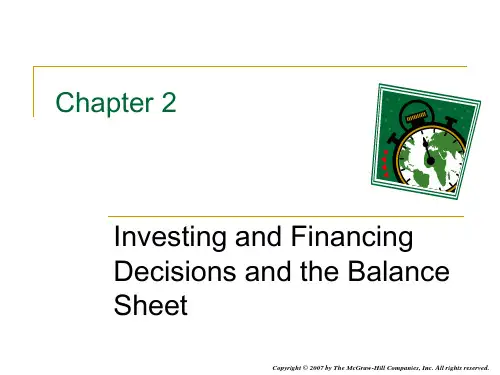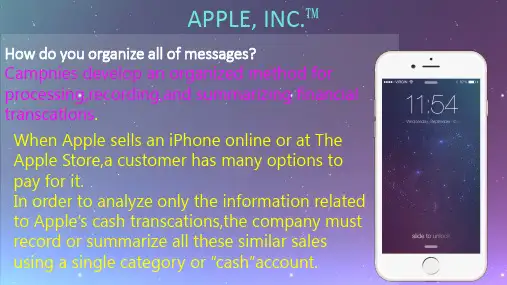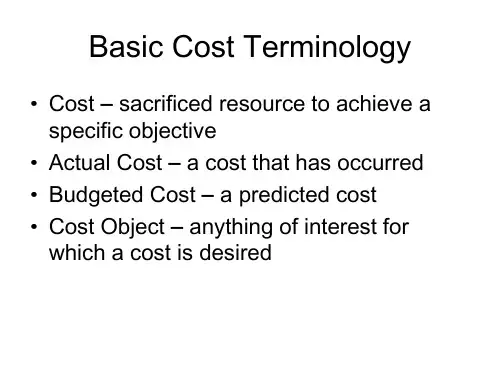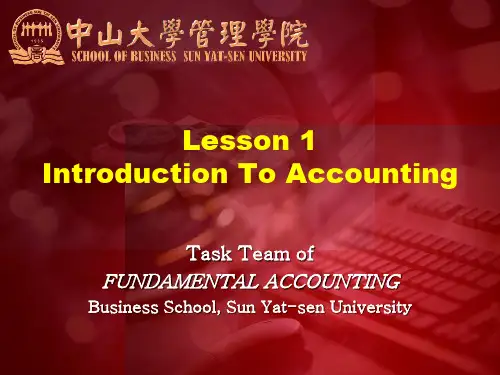会计学基础英文课件 (2)
- 格式:ppt
- 大小:2.10 MB
- 文档页数:50
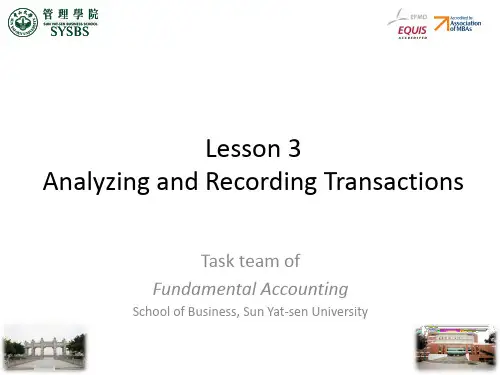
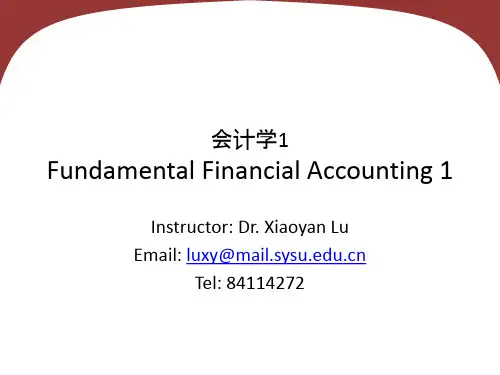
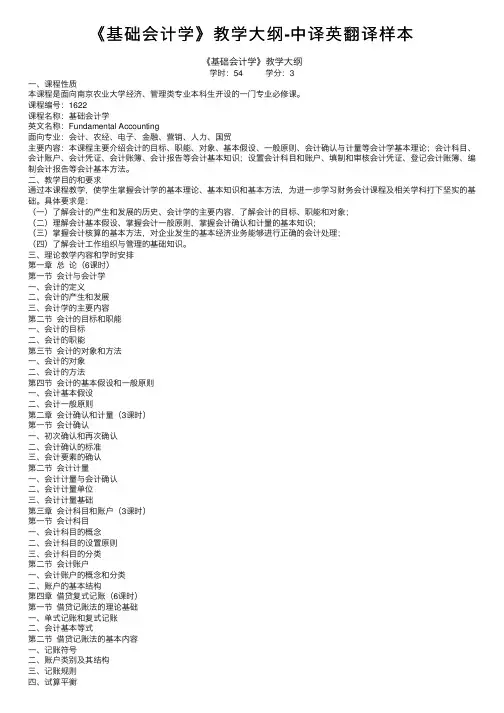
《基础会计学》教学⼤纲-中译英翻译样本《基础会计学》教学⼤纲学时:54 学分:3⼀、课程性质本课程是⾯向南京农业⼤学经济、管理类专业本科⽣开设的⼀门专业必修课。
课程编号:1622课程名称:基础会计学英⽂名称:Fundamental Accounting⾯向专业:会计、农经、电⼦、⾦融、营销、⼈⼒、国贸主要内容:本课程主要介绍会计的⽬标、职能、对象、基本假设、⼀般原则、会计确认与计量等会计学基本理论;会计科⽬、会计账户、会计凭证、会计账簿、会计报告等会计基本知识;设置会计科⽬和账户、填制和审核会计凭证、登记会计账簿、编制会计报告等会计基本⽅法。
⼆、教学⽬的和要求通过本课程教学,使学⽣掌握会计学的基本理论、基本知识和基本⽅法,为进⼀步学习财务会计课程及相关学科打下坚实的基础。
具体要求是:(⼀)了解会计的产⽣和发展的历史、会计学的主要内容,了解会计的⽬标、职能和对象;(⼆)理解会计基本假设、掌握会计⼀般原则,掌握会计确认和计量的基本知识;(三)掌握会计核算的基本⽅法,对企业发⽣的基本经济业务能够进⾏正确的会计处理;(四)了解会计⼯作组织与管理的基础知识。
三、理论教学内容和学时安排第⼀章总论(6课时)第⼀节会计与会计学⼀、会计的定义⼆、会计的产⽣和发展三、会计学的主要内容第⼆节会计的⽬标和职能⼀、会计的⽬标⼆、会计的职能第三节会计的对象和⽅法⼀、会计的对象⼆、会计的⽅法第四节会计的基本假设和⼀般原则⼀、会计基本假设⼆、会计⼀般原则第⼆章会计确认和计量(3课时)第⼀节会计确认⼀、初次确认和再次确认⼆、会计确认的标准三、会计要素的确认第⼆节会计计量⼀、会计计量与会计确认⼆、会计计量单位三、会计计量基础第三章会计科⽬和账户(3课时)第⼀节会计科⽬⼀、会计科⽬的概念⼆、会计科⽬的设置原则三、会计科⽬的分类第⼆节会计账户⼀、会计账户的概念和分类⼆、账户的基本结构第四章借贷复式记账(6课时)第⼀节借贷记账法的理论基础⼀、单式记账和复式记账⼆、会计基本等式第⼆节借贷记账法的基本内容⼀、记账符号⼆、账户类别及其结构三、记账规则四、试算平衡第五章会计凭证(3课时)第⼀节会计凭证概述⼀、会计凭证的概念和种类⼆、会计凭证的作⽤第⼆节原始凭证⼀、原始凭证的基本内容⼆、原始凭证的填制要求三、原始凭证的审核内容第三节记账凭证⼀、记账凭证的基本内容⼆、记账凭证的填制要求和⽅法三、记账凭证的审核内容第六章会计账簿(4课时)第⼀节会计账簿概述⼀、会计账簿的概念和意义⼆、会计账簿的种类第⼆节会计账簿的格式和登记⽅法⼀、⽇记账⼆、总分类账三、明细分类账四、总分类账户和明细分类账户的平⾏登记第三节记账的规则⼀、账簿启⽤规则⼆、账簿登记规则三、错账更正⽅法第四节对账与结账⼀、对账⼆、结账第七章企业基本经济业务的核算(15课时)第⼀节资⾦筹措业务的核算⼀、账户设置⼆、核算举例第⼆节采购业务的核算⼀、账户设置⼆、核算举例第三节⽣产业务的核算⼀、账户设置⼆、核算举例第四节销售业务的核算⼀、账户设置⼆、核算举例第五节利润及其分配的核算⼀、账户设置⼆、核算举例第⼋章财产清查(3课时)第⼀节财产清查概述⼀、财产清查的意义和种类⼆、财产物资的盘存制度第⼆节财产清查的⽅法⼀、实物财产的清查⼆、货币资⾦的清查三、往来款项的清查第三节财产清查的会计处理⼀、账户设置⼆、核算举例第九章财务报告(8课时)第⼀节财务报告概述⼀、财务报告的概念和意义⼆、财务报告的种类三、财务报告的编制要求第⼆节资产负债表⼀、资产负债表的作⽤⼆、资产负债表的结构和内容三、资产负债表的编制⽅法第三节第三节利润表⼀、利润表的作⽤⼆、利润表的结构和内容三、利润表的编制⽅法四、利润分配表第四节第四节现⾦流量表⼀、现⾦流量表的作⽤⼆、现⾦流量表的结构和内容三、现⾦流量表的编制⽅法第五节第五节财务报告分析⼀、偿债能⼒分析⼆、营运能⼒分析三、获利能⼒分析第⼗章会计⼯作组织与管理(3课时)第⼀节会计⼯作组织的意义和原则⼀、会计⼯作组织的意义⼆、会计⼯作组织的原则第⼆节会计机构与会计⼈员⼀、会计机构⼆、会计⼈员第⼀节第⼀节会计法规⼀、会计法规体系⼆、会计法三、会计准则四、会计制度第四节会计档案管理⼀、会计档案的意义⼆、会计档案的⽴卷与归档三、会计档案的保管和调阅四、会计档案的销毁第五节会计电算化⼀、会计电算化概述⼆、会计电算化的特点译⽂:TeachingProgram on Fundamental AccountingCredit Hours: 54 Credits: 3I.Nature of the CourseThe course is a major required course for the undergraduatesin economic and management departments of Nanjing Agricultural University.Course No. 1622Course Name: Fundamental AccountingCourse Name in English: Fundamental AccountingOriented Majors: accounting, agriculturaleconomy, electronics, finance, marketing, human resources and internationaltrade Main Contents: the course mainly introduces the accounting objectives,functions, objects, fundamental assumptions, general principles, accountingconfirmation and measurement and other fundamental accounting theories;accounting subjects, accounts, documents, books, reports and other fundamentalaccounting knowledge; establishing accounting subjects and accounts, fillingout and verifying accounting documents, recording accounting books, preparingaccounting reports and other fundamental accounting methods.II.Teaching Goal and RequirementsThe course aims to allow the students to master fundamental accountingtheories, knowledge and methods, laying solid foundation for further learning financialaccounting and relevant courses, with specific requirements as follows:(I) Learn the creating and developing historyof accounting, the main contents of accounting and the objectives, functionsand objects of accounting;(II) Understand the fundamental assumptions ofaccounting, and master the general principles of accounting and the fundamentalknowledge on accounting confirmation and measurement;(III) Master the fundamental methods of accountingverification, capable of making correct accounting treatment for thefundamental economic business in enterprises.(IV) Understand the fundamental knowledge on theorganization and management of accounting works.III.Arrangement of Contents and Credit Hours of Theoretical Teaching Chapter I GeneralInstruction (6 credit hours)Section 1 Accounting and AccountancyI. Definition ofAccountingII. Creation andDevelopment of AccountingIII. Main Contentsof AccountancySection 2 Objectives and Functions of AccountingI. Objectives ofAccountingII. Functions ofAccountingSection 3 Objects and Methods of AccountingI. Objects ofAccountingII. Methods ofAccountingSection 4 Fundamental Assumptions and GeneralPrinciples of AccountingI. FundamentalAssumptions of AccountingII. GeneralPrinciples of AccountingChapter II Accounting Confirmationand Measurement (3 credit hours) Section 1 Accounting ConfirmationI. Initial Confirmationand Secondary ReconfirmationII. Standards forAccounting ConfirmationIII. Confirmationof Accounting ElementsSection 2 Accounting MeasurementI. AccountingMeasurement and Accounting ConfirmationII. Units ofAccounting MeasurementIII. Basis forAccounting MeasurementChapter III AccountingSubjects and Accounts (3 credit hours)Section 1 Accounting SubjectsI. Concept ofAccounting SubjectsII. EstablishingPrinciples of Accounting SubjectsIII. Classificationof Accounting SubjectsSection 2 Accounting AccountsI. Concept andClassification of Accounting AccountsII. FundamentalStructure of AccountsChapter IV Debit-CreditDouble Entry Bookkeeping (6 credit hours)Section 1 Fundamental Theory of Debit-CreditBookkeepingI. Single EntryBookkeeping and Double Entry BookkeepingII. FundamentalAccounting EquationsSection 2 Basic Contents of Debit-Credit BookkeepingI. BookkeepingSymbolsII. Types andStructures of AccountsIII. Bookkeeping RulesIV. Trial BalanceChapter V AccountingDocuments (3 credit hours)Section 1 Overview of Accounting DocumentsI. Concept and Types of Accounting DocumentsII. Functions of Accounting DocumentsSection 2 Original DocumentsI. Basic Contents of Original DocumentsII. Filling-out Requirements of Original DocumentsIII. Verification Contents of Original DocumentsSection III Bookkeeping VouchersI. Basic Contents of Bookkeeping VouchersII. Filling-out Requirements and Methods ofBookkeeping VouchersIII. Verification Contents of Bookkeeping VouchersChapter VI Accounting Books(4 credit hours)Section 1 Overview of Accounting BooksI. Concept and Meaning of Accounting BooksII. Types of Accounting BooksSection 2 Formats and Recording Methods of AccountingBooksI. JournalII. General LedgerIII. Detailed LedgerIV.Parallel Recording of General Ledger Account and Detailed Ledger AccountSection 3Bookkeeping RulesI. Book Opening RulesII. Book Recording RulesIII. Correction Methods of Accounting ErrorsSection 4 Reconciliation and SettlementI. ReconciliationII. SettlementChapter VII Checking ofBasic Economic Business in Enterprises (15 credit hours) Section 1 Checking of Funding BusinessI. Account SetupII. Examples of CheckingSection 2 Checking of Procurement BusinessI. Account SetupII. Examples of CheckingSection 3 Checking of Production BusinessI. Account SetupII. Examples of CheckingSection 4 Checking of Sales BusinessI. Account SetupII. Examples of CheckingSection 5 Checking of Profit and DistributionI. Account SetupII. Examples of CheckingChapter VIII PropertyInspection (3 credit hours)Section 1 Overview of Property InspectionI. Meaning and Types of Property InspectionII. Property Inventory SystemSection 2 Methods of Property InspectionI. Inspection of Physical PropertyII. Inspection of Monetary FundsIII. Inspection of Current AccountsSection 3 Accounting Treatment of Property InspectionI. Account SetupII. Examples of CheckingChapter IX Financial Report(8 credit hours)Section 1 Overview of Financial ReportI. Concept and Meaning of Financial ReportII. Types of Financial ReportIII. Preparation Requirements of Financial ReportSection 2 Balance SheetI. Functions of Balance SheetII. Structure and Content of Balance SheetIII. Preparation Methods of Balance SheetSection 3 Profit StatementI. Functions of Profit StatementII. Structure and Content of Profit StatementIII. Preparation Methods of Profit StatementIV. Statement of Profit DistributionSection 4 Cash Flow StatementI. Functions of Cash Flow StatementII. Structure and Content of Cash Flow StatementIII. Preparation Methods of Cash Flow StatementSection 5 Analysis on Financial ReportI. Analysis on Debt Paying AbilityII. Analysis on Operating AbilityIII. Analysis on ProfitabilityChapter X Organization andManagement of Accounting Works (3 credit hours) Section 1 Meaningand Principles of Accounting OrganizationsI. Meaning of Accounting OrganizationsII. Principles of Accounting OrganizationsSection 2Accounting Organ and PersonnelI. Accounting OrganII. Accounting PersonnelSection 3 Accounting Laws and RegulationsI. System ofAccounting Laws and RegulationsII. Accounting LawIII. Accounting RulesIV. Accounting SystemSection 4 Management of Accounting ArchivesI. Meaning of Accounting ArchivesII. Establishing and Filing of Accounting ArchivesIII. Keeping and Retrieval of Accounting ArchivesIV. Destruction of Accounting ArchivesSection 5Accounting by EDP (Electronic Data Processing) I. Overview of Accounting byEDPII. Characteristics ofAccounting by EDP。
